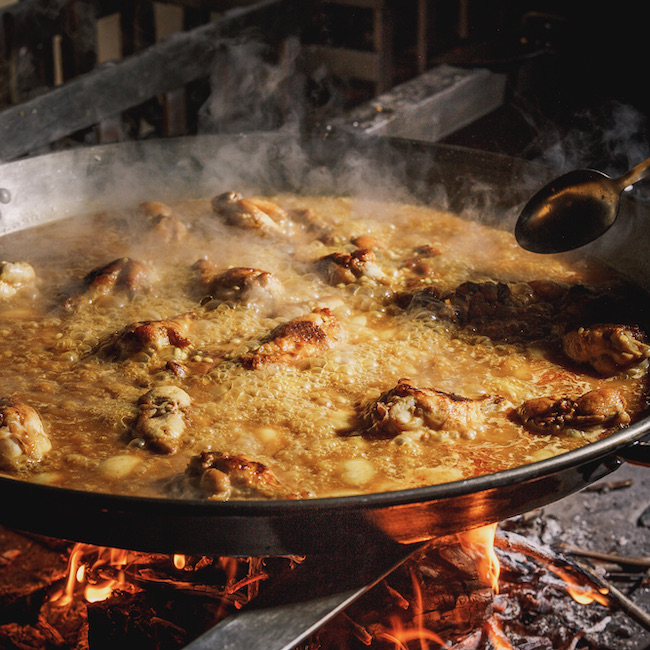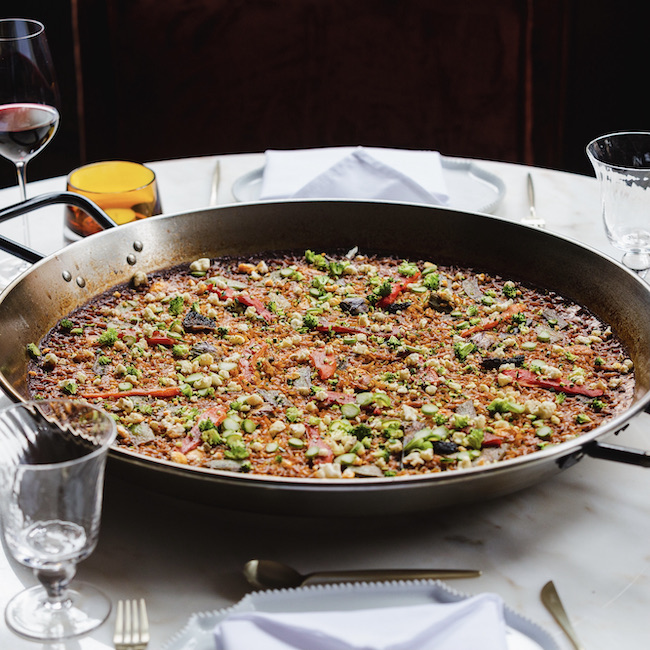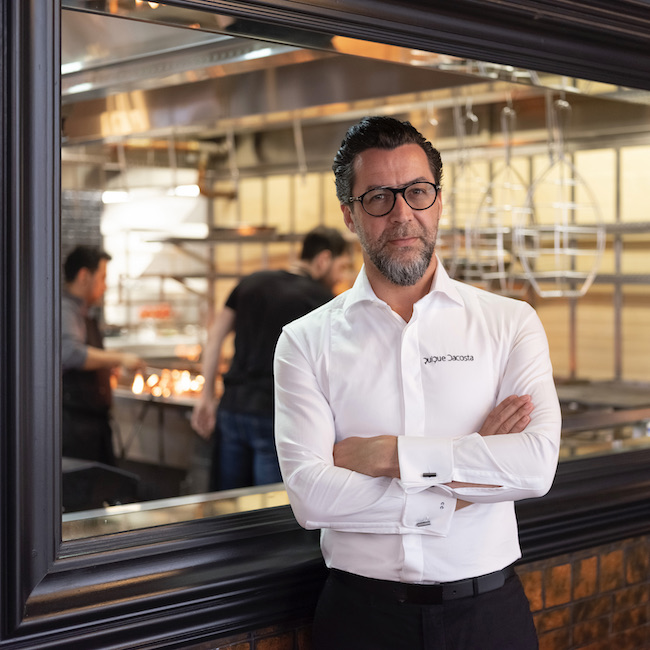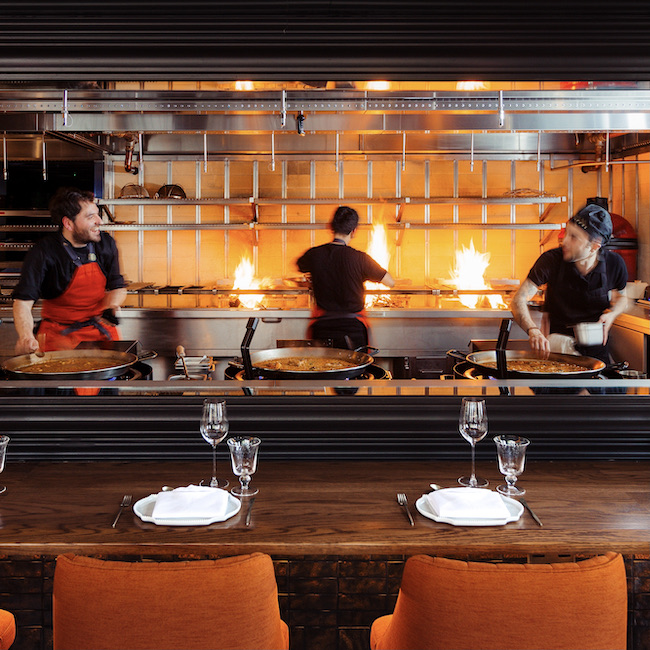.png.transform/rendition-xs/image_image%20(1).png)
Spanish Paella Reimagined in London by Michelin Star Chef Quique Dacosta
How this Michelin-star chef is whipping London’s foodies into a frenzy with his sensational Spanish rice dishes.
 by Ben Holbrook - @ben_holbrook
by Ben Holbrook - @ben_holbrook
Think of Spanish paella and your mind conjures up visions of giant steaming pans overflowing with fresh shellfish and succulent wedges of lemon. But as the many Londoners who have been lucky enough to dine at Restaurant Arros QD will tell you, there’s so much more to Spain’s most famous dish. Opened by three-Michelin-starred chef, Quique Dacosta, Arros QD stands proudly in the heart of Fitzrovia and is a suitably stylish space to explore both traditional and innovative takes on this gastronomic icon. Having begun his love affair with the kitchen in a tiny coastal fishing village in Valencia, the undisputed birthplace of paella, it’s safe to say that Dacosta knows a thing or two about Spanish rice – or “arroz” as it’s known en español (the arròs in the restaurant’s name is the word in Valencian for rice). In fact, he’s even published a book on the subject!
But though he mastered this classic dish at home, it’s in London that he’s showing off his prowess as a three-Michelin-starred chef. “London is a city I love – I have always admired how dynamic it is and how welcoming the city is to new concepts,” says Dacosta. “I am passionate about London and its people.”

Dacosta’s Dream for Authentic Arros in London Town
You might imagine a chef with three Michelin stars to defend would have all sorts of elaborate plans for his first foray outside of Spain, but he continues to respect the age-old recipes passed down to him through the generations. “From the start, our rationale was to celebrate traditional Spanish paella recipes. Our paella Valenciana pays homage to the original paella, made with chicken, rabbit, rice, olive oil, saffron, pimentón (paprika), garrofón (butter beans), and rosemary, all cooked over a fire fuelled with orange tree wood in a shallow paella pan.” That’s right, paella comes from the Meditarranen Sea-facing region Valencia, but it was actually concocted by farmers farther inland and was more likely to feature rabbit and snails than fish and shellfish! As with most styles of food in Spain, paella is more than just a way of eating – it’s a way of living. Like the UK’s Sunday roast, Spain’s rice dishes encapsulate a whole way of life, a culture, a sense of togetherness. Paella is about coming together and indulging in each other’s company while enjoying a freshly made feast. Actually, the word “paella” is the name of the huge pan that the dish is made in, not the dish itself. Paella pans can be so big that they sometimes have to be carried by two or more people, and set up on outside stoves (as they are often too large to fit on traditional kitchen stoves) .“The response I see is that our patrons, both Londoners and Spaniards living in the UK, often return to us after their first visit and soon become regulars,” notes Dacosta.

Understanding the Magic of Spanish Rice
Whereas us Brits may consider there to be two types of rice – white or brown – the Spanish have a wide number of varieties to choose from, reflecting the many people and places that produce this versatile ingredient throughout the country. One of the most popular types of rice used in Spanish paella, however, is called “arroz bomba”, which is less starchy than other varieties and gives paella its irresistible look and texture. But the rice in a good paella is more than just a simple ingredient. As Dacosta explains, “It is a conductor of flavour, a vehicle. If you are cooking rice in a paella pan with lobster, shrimp, fish, chicken, rabbit, or Iberico pork, the rice must take on and distill these flavors – we cannot have flavourless, dull rice,” he says. A inside tip: the best part of a paella is the “socarrat”, the crispy crust of golden, caramelised rice that you scrape off the bottom of the pan.

Arros QD Staples and Signature Creations
For a taste of traditional paella straight from the great Spanish cookbook, Dacosta and his team offer a faithful Mediterranean arroz with cuttlefish, tiger prawns and sea bream, as well as a striking black ink arroz (coloured with squid ink) with Basque cod and sugar snaps. Naturally, the classic “Paella Valenciana” with rabbit, chicken, garrofón beans and rosemary, is also on the menu. But as you might expect (and indeed hope for) from a three-Michelin-starred chef, Dacosta not only sticks to the stalwart recipes of yesteryear but has also put his skills and imagination to good use with a selection of signature dishes. “There is a hidden galaxy to be explored in the universe of rice, and in Arros QD we love to explore. In the last two amazing years at Arros QD, we have created what we call the ‘British Paella’, after asking ourselves: ‘What would have happened if paella had not been born in Valencia, but the UK?’” Take the imaginative paella with local chanterelle woodland mushrooms, broccoli sprouts and cherries, or the hearty paella with grass-fed tomahawk beef from Cornwall, which would satisfy even the most traditional of Valencian farmers.
Perfect ‘Paella-Vino’ Pairings
The Valencians have spent hundreds and thousands of years crafting the perfect wines to accompany their paella and Dacosta suggests this is a good place to start. “A paella Valenciana goes extremely well with red wines from Valencia, such as the ones from Utiel-Requena DO,” he says, but, naturally, insists on white wines to accompany fish/shellfish paellas.“For our British paellas, we also recommend pairing with some of our fantastic British sparkling wines from local vineyards, or even a light beer.”

And if you can’t make it to London just yet?
Dacosta insists that you don’t need three Michelin stars to cook a perfect paella yourself. “Cooking a paella at home is simple! All you need is a paella pan roughly 40 centimeters in diameter, which will be big enough to feed two people, and some proper Spanish bomba rice to accompany your main ingredients – vegetables, fish or meat.” Dacosta is sworn to secrecy and can’t share his famous signature paella stock, but you will find plenty of easy-to-follow recipes here. The beauty of paella is that this ultra-versatile dish works any which way you fancy, so don’t be afraid to invent your own signature version

